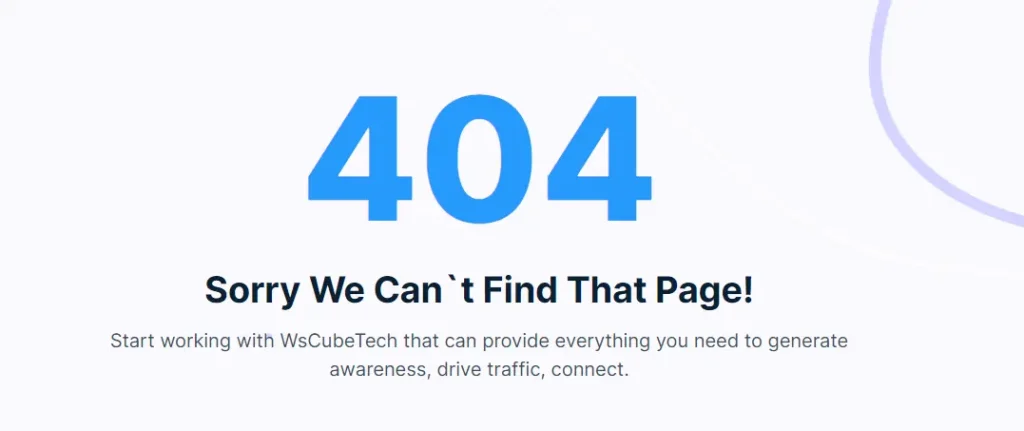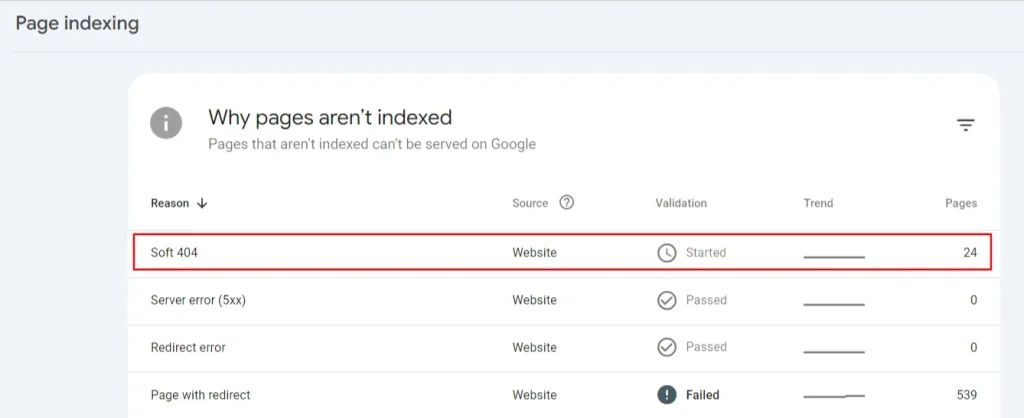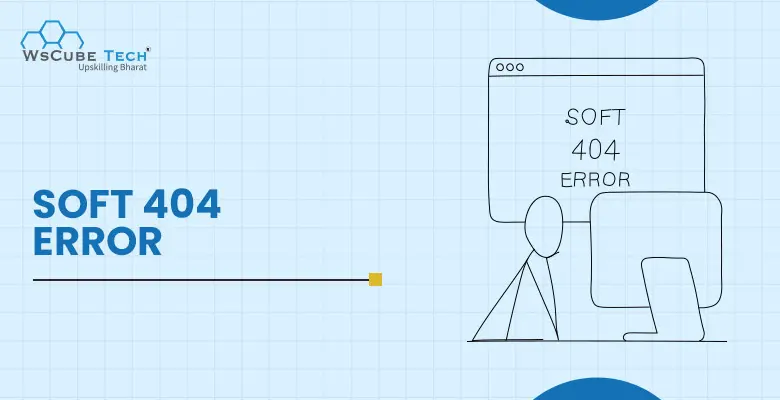If you open a webpage and find an error message hampering your search experience, what would be your reaction? As a user, you will probably be disappointed; close the tab and move on to the next link.
However, for a website owner, this can mean losing out on lead opportunities. If misused, they can also affect the business and harm a website.
A common example of a ‘Page Not Found’ error misused is a soft 404 error, which can affect search engine rankings and brand credibility. Such pages can hurt SEO and website traffic, too.
Therefore, fixing soft 404s is one of the key aspects of technical SEO. However, the reasons behind these errors are often unclear, making it challenging for SEO professionals to troubleshoot and fix them.
This blog explains everything you need to know about soft 404 errors, including their meaning, causes, and ways to resolve them.

What Is a Soft 404 Error?
A standard 404 error means the requested page has been deleted or moved. So, when you try to open the URL, you get the 404 Not Found error rather than the page you want to visit.

It also means that Googlebot already knows that the page doesn’t exist as it has got the same 404 error. Hence, it will not index that page.
However, a soft 404 issue is different as the server returns an HTTP status code 200 OK message rather than the correct HTTP 404 error code. It means that the page exits and is loading.

In simple terms, although the page is invalid, Googlebot gets a 200 OK code instead of the correct error code, showing that the page is still valid. Hence, search engines continue to crawl and index it, showing it in search results.
This is because the 404 error message is not related to the HTTP server response, so the page shows its content stating it’s a 404 page but doesn’t show the same message to the crawlers.
The page returning the 404 error code is not missing but may be empty or contain partial content from other website pages. It can be due to outdated links, misspellings in URLs, or server issues.
Please note that soft 404 is not an official status but is created by Google to alert users. Hence, it continues to crawl that page until there is an action.
Upskill Yourself With Live Training (Book Free Class)
What Causes Soft 404 Errors?
There is no one cause for a soft 404 error. We have listed potential reasons that can lead to 404s:
- When a page has little to no content, it can result in the status code of ‘404 Not Found’. Common examples of 404 errors due to lack of content are empty blog pages, empty product pages, and empty search result pages.
- Google falsely marks a page as a possible soft 404 even when there is nothing wrong with the page.
- You may have accidentally blocked Google from accessing the JS or CSS file used to render pages. When Google can’t access the pages, it can cause 404.
- When there is a temporary issue with crawling, and Google crawls a page, some pages can’t be loaded and return a 404.
- While redirecting a page to another URL, ensure it is relevant. If not, Google will show a 404 error code.
- If you set up multiple tags and leave an empty tag, it shows an empty page, generating a soft 404 error.
- If your page contains phrases found on a 404 page, it can also cause a soft 404.
How Do Soft 404s Affect a Website?
After learning soft 404 meaning and its causes, it’s time to understand its impact on a website.
A soft 404 error can affect your SEO efforts. If your website comprises thousands of pages and only a few of them show a 404 error, then it’s probably fine and will not create any serious issues. However, we recommend delving into the error and trying to fix it.
You need to know the impact of soft 404s and why they matter. Google has a set budget for crawling each website. This crawl budget consists of two aspects:
- Crawl demand refers to how much Google is willing to crawl a website based on its relevance, popularity, frequency of posts, and other factors.
- Crawl rate means the number of requests Googlebot makes to a site per second while crawling.
Google allocates a crawl budget so that Googlebot doesn’t overwhelm a site. This also reduces its work.
When multiple website pages have soft 404 errors, Google continues to index them. As the crawl budget restricts the number of pages crawled and indexed at a time, you can waste that budget on soft 404 error pages. Moreover, Google will crawl the site slowly, and even your top content will not secure higher rankings on search engines.
You surely don’t want that to happen, especially when you invest a lot of time, resources, and effort into producing relevant content. Otherwise, all your SEO initiatives and tactics will be useless and yield no results.
Furthermore, 404 can result in a poor user experience as users will be directed to non-existent pages.
Another impact of a soft 404 error is it can lead to a penalty by Google. When search engines crawl a page that has a soft 404 error and see that its content is missing, they will assume that the site is serving fake 404 errors. Hence, penalizing the website.
Soft 404 issues can also increase the bounce rate. Users will visit the page, see a soft 404 error, and leave the site within seconds. Learn more about bounce rate and engaging visitors in our SEO course that covers basic and advanced topics required to boost a website’s ranking and gain brand visibility.
You can also witness the impact on your website’s operations and performance. 404 error pages may not take much server space but consume bandwidth. So, when search engines drive traffic to a non-existent page, the site still takes hits, which hampers its speed and performance.
Interview Questions for You to Prepare for Jobs
| Digital Marketing Interview Questions | SEO Interview Questions |
| Email Marketing Interview Questions | Content Writing Interview Questions |
How to Find Soft 404 Errors?
Finding a soft 404 error is not challenging. The easiest and most reliable way to discover a 404 error is to use Google Search Console.
- Register your website with Google to get access to its features to improve SEO.
- Log in to Google Search Console, connect your domain, and click on Pages under Indexing to seek the Page Indexing Report.
- Scroll down to find out why your pages are not indexed. Look for soft 404 errors and Not Found errors.
- Click on the error description for further details about the affected pages.
- If 404 pages are excluded, they are not indexed. However, if they are listed as errors, they are still indexed.
- You can use the URL Inspection tool to find the HTTP status response code. Simply enter the URL into the tool, and you can view crawled pages.

How to Fix Soft 404 Errors?
Here are five solutions to fix soft 404 errors:
1. Set Up a Proper 404 or 410 Error
If your page is not valid or available, configure it to return the correct HTTP response code, 404 or 410, and resubmit it to Google. Setting up a proper 404 (Not Found) or 410 (content deleted) error ensures that the crawlers and visitors can see the correct error. Delete the soft 404 error pages so the HTTP server can show them as URL not found.
When it comes to search engines, there’s no major difference between 404 and 410 error codes. Both tell Google not to index the URL. You will find 404 and 410 error pages in most Content Management Systems.
Design a custom 404 page that allows users to choose what they can do next. It can include links to popular pages and homepage along with a search box to enable users find what they want. It is also an excellent branding opportunity.
2. Check If It is a 404 Error or False Alarm
Google Search Console can sometimes make a page 404 by mistake. Hence, make sure that you check if that’s the case with your page. Hiver your cursor over the URL and click “Open in a new tab’. If the page is valid and you want search engines to show it in SERPs, click on VALIDATE FIX.
This will tell Google to recrawl that page and change its status code. As this process can take a few days, you will receive a notification via an email when it’s done.
You can also inspect the URL to get more information about the page and request indexing. However, before taking this step, click the TEST LIVE URL so that Google refreshes the report. This will not require any action and the page will be fine.
3. Redirect the Page Using a 301 Redirect
As you combine content pages or move content on a website, set up a redirect to fix the soft 404. Add a 301 redirect to the new web page to tell search engines that you have moved the page to a new location.
Most CMS come with a built-in redirect tool. Enter the old and new URLs, and the traffic will be redirected automatically. Once it’s done, search engines will crawl the correct pages.
4. Improve the Content and Reindex
At times, when content is irrelevant or short, Google may incorrectly report a soft 404 error even though the page contains content. This is because Google may be good at finding a soft 404 error, but it is not perfect.
So, if your page is important, add more content and improve its quality. This doesn’t mean stuffing it with unnecessary information but making content engaging and relevant that enhances the quality of a website.
Add charts, images, and data-driven content to support your facts and information. This will make your website more credible. Now, resubmit the page to Google so it knows that the page provides valuable information to users and displays the page in search engine results.
5. Keep the Page but Try to De-index It from Search Engines
You can keep the page but add a Noindex directive in the header so that search engines know they don’t have to index that page. You can either manually add it in the page header using <meta name=”robots” content=”noindex,follow”/> or use a tool.
Once done, Google will not index the page and show it under the ERROR report. However, you can still see it in the excluded report under the Soft 404 section.

FAQs About Soft 404 Errors
Soft 404 errors show a ‘Page Not Found’ message for pages that are not communicated properly to search engine crawlers. Website visitors can see the error but not crawl bots. Therefore, they continue crawling and indexing those pages, wasting resources and allocated crawl budgets.
Not Found (404) means the page is not found, and the error returns the HTTP status code 404 or 410. On the contrary, a soft 404 error also shows the page is not found, but it returns the 200 OK code instead of the HTTP status code 404, which can be misleading.
In both cases, the page response code must be 404, but that’s not what happens with the soft 404s. Also, 404 pag pages are not indexed by search engines, so they are not shown in search results. However, soft 404 error pages are indexed by crawl bots and may appear in SERPs.
The major difference between soft 404 and hard 404 is how the two are communicated to search engine crawl bots. For a regular or hard 404, the server shows a 404 error to crawl bots, while for a soft 404, the server shows a 200 OK status, so bots continue to crawl that page.
Once you fix the soft 404 error, the crawl bots can see more active content pages. Hence, it will index more pages and show them in SERPs, driving more website traffic.
No, there is no official penalty for a soft 404 error, but if it is not resolved, there can be some consequences, including poor user experience, reduced traffic, higher bounce rate, and lower online visibility.
Conclusion
Setting up a 404 error page tells search engines and website visitors that a page has been removed from the website. Any mistake while configuring a 404 will not communicate the error properly to bots, causing a soft 404 error. This can result in issues with user experience, search engine rankings, and website traffic.
Hence, it’s better to fix it on time by setting up a 301 redirect, improving page content, reindexing it, and setting up a permanent 404. These methods take a few minutes and can resolve the issue and enhance a website’s performance.
If you want to learn how to optimize web pages, fix soft 404 errors, and boost their rankings in search engines, take WsCube Tech’s online digital marketing course that enhances your practical learning and helps you become career-ready within a few months.
Read more blogs:



